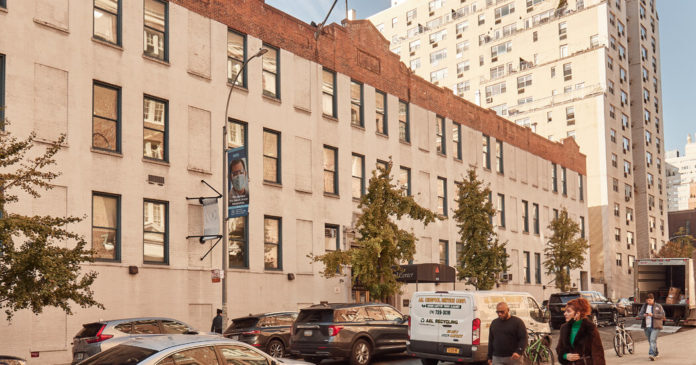
On a quiet block on New York’s Upper East Side, scientists are conducting lifesaving research in an aging, asbestos-floored former trade school.
That is the absurd reality of the New York Blood Center, a critical piece of the region’s health infrastructure in dire need of a serious face-lift.
The research nonprofit oversees the distribution of the bulk of the blood supply for New York City and its suburbs. Its work has played an important role in groundbreaking research on dozens of diseases, even as its home — a nearly century-old, three-story brick building on East 67th Street — is woefully outdated, limiting its potential at a time when its work is needed more than ever.
Finally, a plan to build the modern facility the blood center needs is moving forward. But neighbors on the Upper East Side have mobilized against it, arguing that the proposed 16-story life sciences tower will block sunlight to a park across the street.
Councilman Ben Kallos, who represents the area, vociferously opposes the proposal. Ordinarily, that would sink the project in New York City, where the 51-member City Council almost always defers to the wishes of local members on land-use projects.
Not this time.
When it comes to the blood center, the City Council finally seems to have found its voice.
In an unusual move, the Council appears poised to vote to rezone the land upon which the blood center sits anyway, paving the way for the tower to be built, over Mr. Kallos’s objection. The rezoning plan before the Council would lift a height restriction, allowing the blood center to finance the facility it needs by building higher. Under the current proposal, the blood center would occupy about a fourth of the 233-foot tower.
In a phone conversation, Mr. Kallos called the blood center’s proposal “an overglorified office tower.”
Actually, the rest of the building would be filled by other research institutions and biotech companies. The new development could receive $100 million in tax benefits over 20 to 25 years. The project would be eligible for the benefit under an existing tax incentive for businesses offered by the New York City Industrial Development Agency, a public benefit corporation managed by the city.
That’s a sound investment in New York, which has enormous public health needs and is increasingly staking its economic future on the life sciences industry. As part of the agreement, St. Catherine’s Park across the street will receive $7 million from the city toward improvements, such as replacing the playground and sidewalks. The blood center will give an additional $3.6 million to the park and $2 million to a public school across the street.
In a last-minute bid to block the project, owners of a luxury building nearby filed a protest against the rezoning, triggering a little-known provision of the City Charter. Now the rezoning will likely require a supermajority of 39 members, rather than 26.
Though a large majority of the City Council supports the project, at least some members are wary of overriding the opposition of their colleague, a break with custom.
While community input is important, reflexively deferring to the wishes of a single local councilor is not always in the best interest of the city. Sometimes communities try to stop affordable housing where it is needed most. Sometimes they try to keep Black and Latino children out of neighborhood schools.
This is a time for political courage.
The blood center, humble though it may be, plays a key role in the city’s health care ecosystem. It also does research on diseases and viruses that disproportionately affect marginalized communities, like sickle cell, H.I.V. and diabetes. If the City Council can stand firm, it can set an important precedent, showing through action that it is prepared to move forward with development that is in the interests of the entire city.
The blood center is also essential outside New York City. Over the past 57 years, its work has contributed to substantial medical breakthroughs. Researchers at the center did work that helped develop an H.I.V. vaccine candidate, along with vaccines for SARS and MERS. They invented a low-cost vaccine for hepatitis B. Their work has helped pioneer novel treatments to treat sickle cell disease, work that continues. The center created the first public cord blood bank to support transplant patients. Its scientists are investigating therapies for blindness, deafness, autism, brain injuries and Alzheimer’s.
All this is hard to imagine when standing inside the center’s current home, a building more suited for a museum than a world-class research facility.
Modern lab equipment sits atop ancient wooden and laminate built-ins once used for trade school students.
Giant containers of liquid nitrogen freezers sit in the basement, far from the main labs, because the building isn’t strong enough to support them on the floors above.
Also in the basement is a room filled with dozens of freezers that wouldn’t look out of place in the average American garage. Barry Greene, a vice president at the center, said the freezers contain blood samples with all manner of blood-borne diseases, including some of the earliest known samples of H.I.V. in the United States.
Mr. Kallos and others opposed to the project have said the new blood center should be built smaller or simply be moved somewhere else.
This is a bad idea for several reasons. For starters, the blood center owns its current building, an asset that can be leveraged. It can’t afford to acquire a new property. The blood center is steps away from Weill Cornell Medical College and Rockefeller University — proximity that allows for greater collaboration. It should remain in the neighborhood, in the heart of the city’s thriving life-sciences corridor.
The center has played another vital role: hosting meetings for the local community board amid the faded red seats of the current building’s auditorium, a throwback dating back to the trade school.
Concerns on the Upper East Side about sunlight and open space are real and valid. They just don’t justify scrapping a project to modernize a key part of New York’s health care system that serves the entire city, and millions of people beyond its borders.








